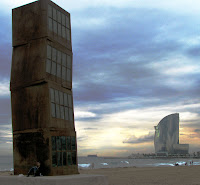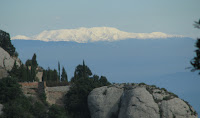We took off the first morning to visit what is probably the most famous basilicas in the entire country – at least in Barcelona anyway. It was designed by a local architect, Antoni Gaudi and although the building of it was started in 1882, it has already taken over 100 years to build – and it is still NOT finished! Not only is it still under construction, they are also cleaning and refurbishing the original work because it is, well, old. It is totally unique with Gothic and “Art Nouveau” blended around the building. Hmmm…perhaps blended is not the best word.
Actually, each side is built in a totally different style and you can see bits and pieces of each style everywhere you look. The colored organic looking bulb actually has windows built into it to allow light into the nave down below.
The Nativity Façade is very Gothic with extremely ornate, naturalistic style, incorporating many different animals, plants, as well as people, with great detail showing the birth of Jesus. As Gaudi envisioned it, each figure has some importance; chameleons as a symbol of change while the two tortoises (or are they turtles?) represent the land and the sea as well as the permeability of stone (now, if the book didn’t tell me that, I would have never guessed). They are, however, intricately carved, have incredible detail and probably the portion of the exterior of the church that has the greatest Gaudi influence (he, of course, did not live to see the building built).
The Passion Façade, by contrast, is austere, simple and harsh in a modernistic Art Nouveau style. The figures are squared off and sparse and angular with few details to support the dramatic effect. It is a complete contrast to the ornate, detailed side next to it. It was actually constructed by Josep Subirachs, following the designs left by Gaudi and is supposed to strike fear into the local people. k
The final side, called the Glory Façade, will eventually be the main entrance to the basilica. It is still under construction and totally behind tall columns of plastic and steel so I have no idea what that will look like.
The interior of the church is totally unique, representing, again, naturalistic elements. The supporting columns branch out like trees with overhanging and drooping leaves descending from the ceiling. Numerous open areas allow light to filter in and while there are stained glass windows, many are just clear, open spaces with full light (although the fruity pieces on top allow some colored light in). While this style is less detailed that the gothic presentation outside, it still includes elaborate curves, abstract shapes and intricate details worked into the iron railings and walls.
Gaudi’s influence is seen across Barcelona, and out across Catalanya (the north eastern portion of Spain, in odd buildings here and there, a rooftop, a corner in a park. This particular honeycomb design can be found in random walkways and across buildings. I really like the way it fits together and continues growing – very organic.
 Most of the apartments had the tiny balconies overlooking the streets, some balconies large enough for chairs and tables, others filled with plants, bikes, or toys. On the main squares and the Rambla, people would sit out and watch the crowds down below. Ours, sadly, was one of the few without a balcony in front. We did have a bit of one in the back but it overlooked clothes lines – not particularly exciting.
Most of the apartments had the tiny balconies overlooking the streets, some balconies large enough for chairs and tables, others filled with plants, bikes, or toys. On the main squares and the Rambla, people would sit out and watch the crowds down below. Ours, sadly, was one of the few without a balcony in front. We did have a bit of one in the back but it overlooked clothes lines – not particularly exciting. 

















































